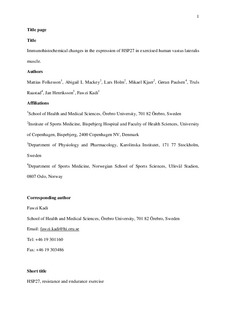| dc.contributor.author | Folkesson, Mattias | |
| dc.contributor.author | Mackey, Abigail L. | |
| dc.contributor.author | Holm, Lars | |
| dc.contributor.author | Kjær, Michael | |
| dc.contributor.author | Paulsen, Gøran | |
| dc.contributor.author | Raastad, Truls | |
| dc.contributor.author | Henriksson, Jan | |
| dc.contributor.author | Kadi, Fawzi | |
| dc.date.accessioned | 2009-09-16T08:18:51Z | |
| dc.date.issued | 2008-06-28 | |
| dc.identifier | Seksjon for fysisk prestasjonsevne / Department of Physical Performance | |
| dc.identifier.citation | Acta Physiologica. 2008, 194(3), 215-222 | en |
| dc.identifier.issn | 1748-1708 | |
| dc.identifier.uri | http://hdl.handle.net/11250/170535 | |
| dc.description | I Brage finner du siste tekst-versjon av artikkelen, og den kan inneholde ubetydelige forskjeller fra forlagets pdf-versjon. Forlagets pdf-versjon finner du på http://www3.interscience.wiley.com/journal/119881738/abstract / In Brage you'll find the final text version of the article, and it may contain insignificant differences from the journal's pdf version. The definitive version is available at http://www3.interscience.wiley.com/journal/119881738/abstract | en |
| dc.description.abstract | Aim: The role of HSP27 in the adaptive process of skeletal muscle to exercise, especially in humans, is not well understood. The objective of this study was to investigate immunohistochemical changes in HSP27 expression in human vastus lateralis muscle following resistance and endurance exercises.
Methods: Two different exercise protocols were used: (1) one-leg ergometer cycling (EC, n = 6) consisting of two 30-min bouts at 40% and 75% of peak oxygen uptake, respectively, and (2) leg extension resistance exercise (RE, n = 9) including 10 sets of eight repetitions at a load corresponding to 70% of one maximal repetition (1RM). Immunohistochemistry using specific monoclonal antibodies was used to determine the location of HSP27 protein in muscle biopsies from human vastus lateralis.
Results: Our results show that RE, but not EC, induced a significant appearance of scattered accumulations of HSP27 protein in muscle fibres from five of nine subjects. The number of fibres with accumulation of HSP27 in RE ranged from 0% to 32% with a mean of 6.3% of the total number of fibres.
Conclusion: We conclude that this rapid HSP27 protein relocation after RE is an important player in the cellular remodelling of human muscle fibres in response to exercise involving high-force contractions, but not in response to endurance exercises. | en |
| dc.format.extent | 457226 bytes | |
| dc.format.mimetype | application/pdf | |
| dc.language.iso | eng | en |
| dc.publisher | Wiley | en |
| dc.subject | adaptation | en |
| dc.subject | endurance and resistance exercise | en |
| dc.subject | fibre type | en |
| dc.subject | heat shock protein | en |
| dc.subject | stress response | en |
| dc.title | Immunohistochemical changes in the expression of HSP27 in exercised human vastus lateralis muscle | en |
| dc.type | Peer reviewed | en |
| dc.type | Journal article | en |
| dc.subject.nsi | VDP::Medical disciplines: 700::Basic medical, dental and veterinary science disciplines: 710 | en |
| dc.source.pagenumber | 215-222 | en |
| dc.source.volume | 194 | en |
| dc.source.journal | Acta Physiologica | en |
| dc.source.issue | 3 | en |
